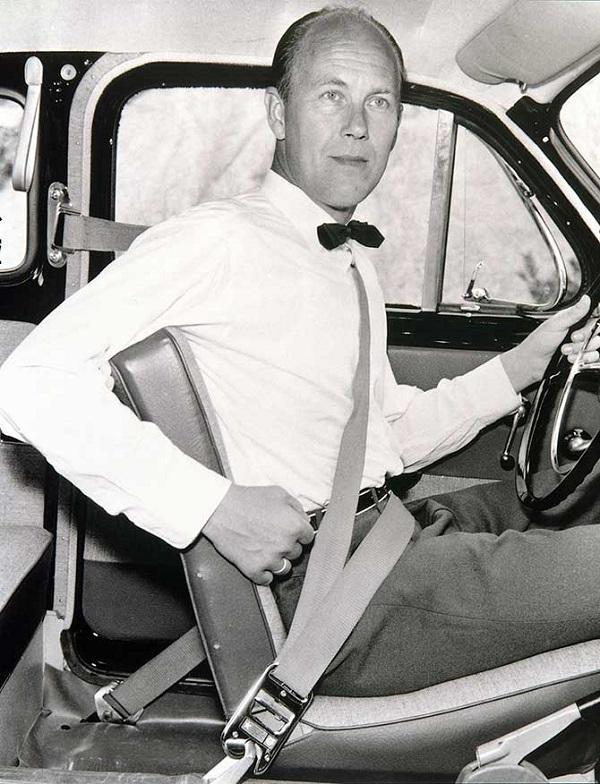Seat belts are one of the most important safety devices in vehicles and have been credited with saving millions of lives. The three-point seat belt, the most common type, spreads the energy of a moving body over the chest, pelvis, and shoulders in the event of a collision or sudden stop.
The concept of seat belts can be traced back to the mid-19th century when English engineer George Cayley invented them for use on his glider. But, it wasn’t until 1885 that the first patented seat belt was made by American Edward J. Claghorn. This was to keep tourists safe in taxis in New York City. Slowly but surely, seat belts started appearing in cars, more to keep passengers in their seats than for overall driving safety. Fast forward to the mid-1930s, and U.S. doctors were testing lap belts and seeing the positive impact they had on safety. They urged car manufacturers to include seat belts in all cars. By 1954, the Sports Car Club of America required drivers to wear lap belts during races, and the following year, the Society of Automotive Engineers formed a committee to focus on seat belt safety. It was actually race car drivers who were the first to start wearing seat belts to protect themselves against serious internal injuries.
In 1955, Americans Roger W. Griswold and Hugh DeHaven patented the three-point seat belt design. The design was later developed by Swedish inventor Nils Bohlin, who worked for Volvo in the 1950s. Bohlin, a former aviation engineer, used his knowledge of the effects of extreme forces on the human body to create the three-point seat belt. The design was first introduced as standard equipment in Volvo cars in 1959 and was granted a U.S. Patent.
Despite the obvious benefits of seat belts, it took several years for them to become widely used. Nash was the first American car manufacturer to offer seat belts as an option in 1949, but buyers didn’t want them, and dealers often removed them. Ford offered seat belts as an option in 1955, but only 2% of buyers chose to pay for them. It wasn’t until 1966 that Congress passed the National Traffic and Motor Vehicle Safety Act, requiring all cars to have certain safety standards, including seatbelts.

In 1970, the first compulsory seatbelt law was put in place in Victoria, Australia, and mandatory seatbelt laws were introduced in the U.S. in the 1980s. Studies have shown that seat belts can reduce serious injury and death by about half during a crash. The Centers for Disease Control and Prevention in the U.S. has found that seat belts save lives.
Despite some opposition to mandatory seatbelt laws, the evidence is clear – seat belts save lives. To ensure that seat belts are effective, they must be used properly, with no slack in the belt during an accident. The next time you buckle up, take a moment to appreciate the three-point seat belt, a simple yet life-saving device that has been protecting drivers and passengers for over 60 years.
About Nils Ivar Bohlin
Nils Ivar Bohlin was a Swedish mechanical engineer and inventor who made a significant impact on automotive safety. Born on July 17, 1920, in Härnösand, Sweden, Bohlin received a diploma in mechanical engineering from Härnösand Läroverk in 1939. He began his career at aircraft maker Saab as an aircraft designer and helped develop ejection seats.
In 1958, Bohlin joined Volvo as a safety engineer and went on to invent the modern three-point safety belt, which is now a standard safety feature in all cars. After testing his invention, he introduced it to the Volvo company in 1959 and received his first patent. He retired from Volvo as Senior Engineer in 1985 and was posthumously inducted into the National Inventors Hall of Fame.
Bohlin was recognized for his contributions to automotive safety throughout his career. In 1974, he received the Ralph Isbrandt Automotive Safety Engineering Award and was inducted into the Hall of Fame for Safety and Health in 1989. He also received a gold medal from the Royal Swedish Academy of Engineering Sciences in 1995 and was inducted into the Automotive Hall of Fame in 1999.

Bohlin’s three-point seat belt changed the world by preventing injuries during car crashes. The US National Highway Traffic Safety Administration says that seat belts save about 15,000 lives per year in the US. Bohlin demonstrated the effectiveness of his invention in a study of 28,000 accidents in Sweden and presented a paper at the 11th Stapp Car Crash Convention. The study resulted in the US Department of Transportation requiring three-point seat belts in American cars, and in most industrial countries, occupants are now required by law to use seat belts.
Bohlin died on September 21, 2002, at the age of 82, of a heart attack. He was buried at Torpa Church in Ramfall, Ydre Municipality, Sweden. During his life, he was married to Maj-Britt Bohlin and was a stepfather to her two sons then they had two children together and thirteen grandchildren.
Conclusion
Folks, approximately 60 years ago, the world got a lot safer thanks to the invention of the three-point seat belt. This little invention is still considered the most important traffic safety innovation in history and is estimated to have saved over a million lives. Can you believe it? Just buckling up can make the difference between life and death. Reports show that if drivers and passengers take the time to put on their seat belts, their chances of surviving a serious car crash double.
References:
- https://en.wikipedia.org/wiki/Nils_Bohlin
- https://en.wikipedia.org/wiki/Seat_belt
- https://www.caranddriver.com/news/a28775593/three-point-seatbelt-history/
- https://commons.wikimedia.org/wiki/File:Seatbelt.jpg
You know, I was just reading about the three-point seat belt and the amazing impact it’s had on saving lives. And it got me thinking about the importance of safety in all aspects of our lives, especially in the workplace. That’s why I’m excited to share with you an online training system that’s designed to keep your employees safe and informed.
Just like the three-point seat belt revolutionized the safety of being in a vehicle, this online training system is revolutionizing the way we approach workplace safety training. It’s not just about keeping employees informed, it’s about keeping them engaged and invested in their own safety. With full-motion HD video filmed in real-life workplace settings and interactive quiz questions, employees will be fully invested in what they’re learning. And if they miss a question, the system even provides remediation training to make sure they understand the material.
This system is also a great tool for managers, as it tracks and records training activity and test scores, making it easy to monitor employee progress. And with a range of different types of online safety courses, including adaptive learning courses, micro-learning courses, full-length interactive courses, and video streaming (VOD) courses, there’s something for everyone.
So, if you’re looking to make your workplace safer and your life easier, sign up for a free demo of this online training system today. You won’t regret it. Just like how the three-point seat belt has saved millions of lives, this system has the potential to make a real impact in your workplace. Buckle up for safety, folks!

